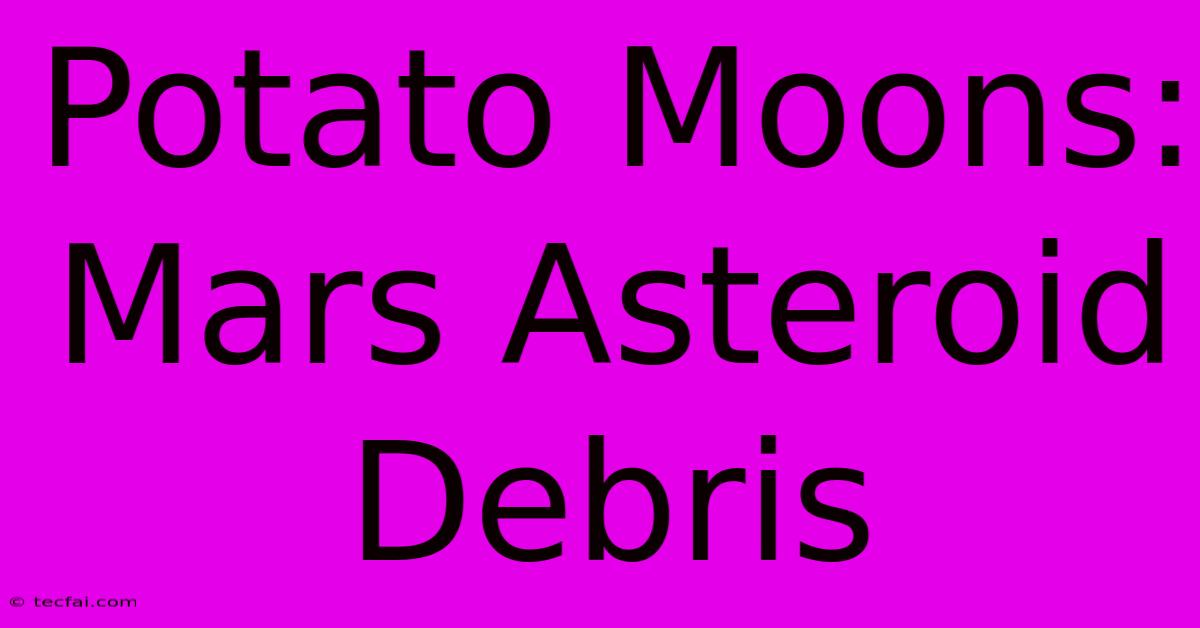Potato Moons: Mars Asteroid Debris

Discover more detailed and exciting information on our website. Click the link below to start your adventure: Visit Best Website tecfai.com. Don't miss out!
Table of Contents
Potato Moons: Mars Asteroid Debris – Unraveling the Mysteries of Phobos and Deimos
The Martian moons, Phobos and Deimos, are intriguing celestial bodies that have captivated scientists for decades. Often described as "potato-shaped," these small moons present a unique puzzle within our solar system, leading many to believe they are captured asteroids rather than formed alongside Mars. This article delves into the compelling evidence supporting this theory and explores the ongoing research surrounding these fascinating Martian companions.
The Case for Captured Asteroids
The irregular shapes of Phobos and Deimos are the first significant clue. Unlike the relatively spherical moons orbiting other planets, these Martian satellites exhibit highly irregular, lumpy forms. This irregular morphology strongly suggests an asteroidal origin, as asteroids typically lack the gravitational force necessary to form a spherical shape during their formation. Their low density further supports this hypothesis. Their composition, primarily consisting of carbonaceous material, aligns more closely with the composition of asteroids than with the material expected in a moon formed from the same planetary disk as Mars.
Spectroscopic Evidence: The Compositional Clue
Spectroscopic analysis of Phobos and Deimos provides further compelling evidence. The spectral signatures of these moons show a remarkable similarity to D-type asteroids, a common class of asteroid found in the outer asteroid belt. These asteroids are characterized by their dark, reddish surfaces and relatively low albedo (reflectivity). This compositional match lends significant credence to the captured asteroid theory.
The Capture Mechanism: A Gravitational Tug-of-War
While the evidence suggests an asteroidal origin, the precise mechanism of their capture remains a subject of ongoing debate and research. One prominent theory suggests a gravitational interaction with Mars, possibly involving a close encounter or a series of gravitational assists that slowed the asteroids sufficiently for Mars to capture them into orbit. This process, though complex, is considered plausible given the gravitational forces at play in the early solar system. Factors like the initial velocity of the asteroids and the presence of other celestial bodies likely played crucial roles in their capture.
Simulating Capture: Computational Astrophysics at Work
Modern computational astrophysics plays a vital role in investigating this capture mechanism. Researchers utilize sophisticated computer models to simulate various scenarios, investigating the probability of different capture events and refining our understanding of the complex gravitational dynamics involved. These simulations help constrain the range of possible capture scenarios, further solidifying the captured asteroid theory.
Ongoing Research and Future Missions
Despite significant progress, many questions remain unanswered regarding Phobos and Deimos. Ongoing research continues to focus on the detailed analysis of their composition, internal structure, and geological history. Future missions are planned to provide more in-depth data. These missions will involve sophisticated instruments capable of close-range analysis of the moons' surface and subsurface, which will yield vital information to refine our understanding of their origins and evolution.
The Significance of Studying Phobos and Deimos
Understanding the formation and evolution of Phobos and Deimos provides valuable insights into the early solar system's dynamics. Studying these small moons can help scientists better understand the processes involved in planetary formation, asteroid capture, and the evolution of planetary systems in general. Moreover, these moons could potentially serve as valuable resource locations for future human exploration of Mars.
Conclusion: Potato-Shaped Mysteries Unfolding
Phobos and Deimos, the potato-shaped moons of Mars, present a compelling case study in planetary science. The evidence strongly suggests they are captured asteroids, representing a unique glimpse into the chaotic and dynamic early solar system. Ongoing and future research promise to further unravel the mysteries surrounding these fascinating Martian companions, deepening our understanding of the solar system's past and enriching our knowledge of celestial mechanics.

Thank you for visiting our website wich cover about Potato Moons: Mars Asteroid Debris. We hope the information provided has been useful to you. Feel free to contact us if you have any questions or need further assistance. See you next time and dont miss to bookmark.
Featured Posts
-
Nikki Kaye A Life In 44 Years
Nov 26, 2024
-
Kenyas National Bank Sale Postponed
Nov 26, 2024
-
Sonic 3 Trailer Keanu Reeves Joins Cast
Nov 26, 2024
-
More Bank Holidays Uk 2025
Nov 26, 2024
-
Youngest Ipl Player An Indian Prodigy
Nov 26, 2024
